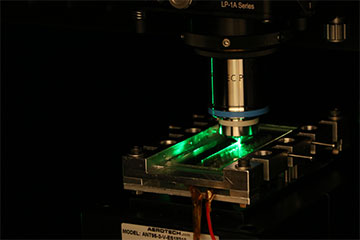
Sapphire optical fiber. [Image: J. Fells, University of Oxford]
Because of their inherent sturdiness, sensors made from fiber Bragg gratings are widely used for remote monitoring of properties like temperature and strain in extreme environments. Most commonly, the sensors employ silica optical fiber, meaning their operating temperature will top out at 1000 °C due to wavelength drift.
Now, researchers at the University of Oxford, UK, have created a new type of fiber Bragg grating made from sapphire optical fiber, a material that should withstand temperatures greater than 2000 °C (Opt. Express, doi: 10.1364/OE.446664). The resulting sensors may allow for more accurate measurements in ultra-harsh environments such as aircraft engines, nuclear reactors and spacecraft.
Rings around the core
A fiber Bragg grating consists of a short segment of optical fiber with a periodically varying refractive index along its length. It acts as a wavelength-selective mirror, reflecting light at a so-called Bragg wavelength defined by the period of the structure and the refractive index of the fiber core. Both temperature and strain affect these properties, which give a fiber Bragg grating the ability to perform as a sensor.
Sapphire fiber Bragg gratings have existed for nearly 20 years, but they suffered from a fundamental flaw that prevented widespread adoption for commercial sensing applications. All sapphire fiber is intrinsically multimode, with each mode having a different effective refractive index. Therefore, the structure will reflect at many wavelengths over a relatively wide bandwidth, preventing it from acting as an accurate sensor.
To overcome this longstanding issue, the researchers decided to transform an existing multimode sapphire fiber into a single-mode fiber by writing a single-mode waveguide within it. They used a femtosecond laser to inscribe rings around the central core area of a 1-cm-long sapphire fiber, lowering the refractive index and effectively forming a “depressed cladding” waveguide.
“We needed to verify that that the waveguides were single-mode. We measured the waveguide mode profile and the Bragg reflection spectrum and confirmed that everything was consistent with the theory,” says the first author Mohan Wang at the University of Oxford. “We also heated samples up to 1000 °C to confirm the structures survived.”
Testing for real-world applications
Next, Wang and her colleagues are conducting high-temperature testing on longer fibers, as well as exploring opportunities with collaborators in industry and government for real-world sensing applications. For example, they plan to work with Rolls-Royce on aircraft engine test-rigs to enable more efficient and accurate multi-point temperature measurements. The researchers will also supply devices to the UK Atomic Energy Authority (UKAEA) for evaluation by their Remote Applications in Challenging Environments (RACE) Division.
“These sapphire optical fibers will have many different potential applications within the extreme environments of a fusion energy power plant,” said Rob Skilton, Head of Research at RACE at the UK Atomic Energy Authority, in a press release. “This technology has the potential to significantly increase the capabilities of future sensor and robotic maintenance systems in this sector, helping UKAEA in its mission to deliver safe, sustainable, low-carbon fusion power to the grid.”
